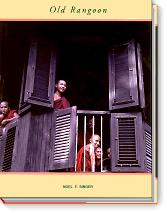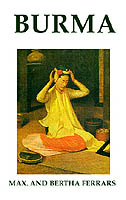Book Review: Old Burma, Older Myanmar
OLD BURMA, OLDER MYANMAR
(Asia Times)
Review: "Old Rangoon" By Noel F. Singer (Kiscadale, US$45); "Burma" by Max and Bertha Ferrars (Ava Publishing, US$50); and "Myanmar: Land of the Spirit" ed. Gillian Cribbs (Co and Bear Productions Ltd, US$70). Toward the end of the 16th Century, a little-known Portuguese adventurer named Felipe de Brito sailed into the Burmese port of Syriam and, taking advantage of a spell of political instability, set up his own private kingdom. For 13 years he ruled much of lower Burma like a petty demagogue, tearing down pagodas and ransacking the countryside, until the Burmese king Maha Dhamma Raja decided he'd had enough, and put an end to the shenanigans.
Toward the end of the 16th Century, a little-known Portuguese adventurer named Felipe de Brito sailed into the Burmese port of Syriam and, taking advantage of a spell of political instability, set up his own private kingdom. For 13 years he ruled much of lower Burma like a petty demagogue, tearing down pagodas and ransacking the countryside, until the Burmese king Maha Dhamma Raja decided he'd had enough, and put an end to the shenanigans.
The price de Brito paid for his brief reign was brutal: the king had him impaled on an iron stake on the outskirts of the city, where he lingered, alive but in agony, for almost a week. His beautiful and aristocratic wife Donna Luisa de Saldana, meanwhile, was kept in a river for three days until she was thought to be properly clean, then brought to the king's bed. When she scorned him, the king didn't take it well -- he bored holes through her legs, shackled them together and sold her off as a common slave.
For most of the last several centuries, much of the history of Burma (now known as Myanmar) has echoed de Brito's story on an epic scale -- a pageant of sudden rises to power and brutal falls, of bloody clashes between East and West, of extraordinary beauty and extraordinary horror. To a large degree, that history has been played out in Yangon, a city that embodies those conflicts -- built largely by British imperialists, it is centered around the country's most sacred spot, the Shwedagon Pagoda.
In his "Old Rangoon: City of the Shwedagon," Noel F. Singer explores this exotic history, from the first written mention of the country (Ptolemy claimed in 125 AD that it was inhabited by "cannibals and white-skinned, flat nosed hairy dwarfs") to the end of the Second World War, when it finally achieved independence from Britain. It's a compelling story, full of intrigue and rebellions, and one that Singer knows well.
It's the inherent fascination of the events, rather than Singer's rather clunky literary style, that keeps the book moving. But no matter: this is still a worthwhile and very enjoyable read, especially for anyone touring Yangon. Much of the city still looks much as it did fifty years ago, and Singer's tales resonate vividly, even to the casual visitor. Replete with photographs (some historical, others taken by publisher Paul Strachan) as well as old prints, maps, engravings and dozens of hand-tinted postcards, "Old Rangoon" holds up as a serious history of the city for readers -- and as pleasant entertainment for flippers.  A book that's just as intriguing -- but more for the confirmed Burmaphile than the casual reader -- is a new reprint of the 1901 classic "Burma" by Max and Bertha Ferrars. Part of the book's charm is the seriousness with which it goes about methodically dissecting Burmese turn-of-the-century society, with detailed examinations of everything from fun ("slashing cocoanuts is a favorite sport in the North") to health ("rheumatism is common in Burma. It is treated by shampooing") to the preparation of a monk's corpse for the funeral ("mercury is poured in at the mouth and honey is applied externally").
A book that's just as intriguing -- but more for the confirmed Burmaphile than the casual reader -- is a new reprint of the 1901 classic "Burma" by Max and Bertha Ferrars. Part of the book's charm is the seriousness with which it goes about methodically dissecting Burmese turn-of-the-century society, with detailed examinations of everything from fun ("slashing cocoanuts is a favorite sport in the North") to health ("rheumatism is common in Burma. It is treated by shampooing") to the preparation of a monk's corpse for the funeral ("mercury is poured in at the mouth and honey is applied externally").
In fact, the encyclopedic detail of the book makes it as fascinating as -- well, as a good encyclopedia, and as full of surprising and unexpected information. With photographs on literally every page (ancient, grainy and in black and white, but some true gems) "Burma" contains one beguiling factoid after another. "The ratio of insane in the population is about a quarter of Western Europe or America, but is double that of India," the Ferrars mention, in case you were wondering. And where else will you find a step-by-step guide to building a pagoda? Probably not in "Myanmar: Land of the Spirit", a gorgeous new coffee table-sagger from Co and Bear Productions. It won't tax anyone's brain cells too much, but "Myanmar" is well worth its price tag as a no-stone-left-unphotographed look at the natural beauty of the country and its people.
Probably not in "Myanmar: Land of the Spirit", a gorgeous new coffee table-sagger from Co and Bear Productions. It won't tax anyone's brain cells too much, but "Myanmar" is well worth its price tag as a no-stone-left-unphotographed look at the natural beauty of the country and its people.
Some of the best photographers of Myanmar are in top form here, including Tim Hall, National Geographic photographers Steve McCurry and Bruno Barbey, Zaw Min Yu (Myanmar's best-known photographer) and former AP photographer Barry Broman, who also serves as an American diplomat in Yangon.
There is, of course a text, and a couple of the essays are quite good, including a new piece by Norman Lewis (author of the classic "The Golden Earth"). But the words are mostly used to fill up space between the glowing, light-drenched pictures, many of which are unforgettable. For anyone in the market for a photographic paean to Myanmar, this will probably fit the bill exactly.
References (4)
-
 Response: structural analysis pdf
Response: structural analysis pdf -
 Response: edubirdie reviewsOne of the best book, I have ever read in recent times, the author has great view and it's the best and outstanding experience for me. Last year I read about the author biography in a service, the strategies were worthy and unbelievable. I would really expect more books from the ...
Response: edubirdie reviewsOne of the best book, I have ever read in recent times, the author has great view and it's the best and outstanding experience for me. Last year I read about the author biography in a service, the strategies were worthy and unbelievable. I would really expect more books from the ... -
 Response: chinese philosophy books
Response: chinese philosophy books -
 Response: An Overview of American Africans
Response: An Overview of American Africans


Reader Comments